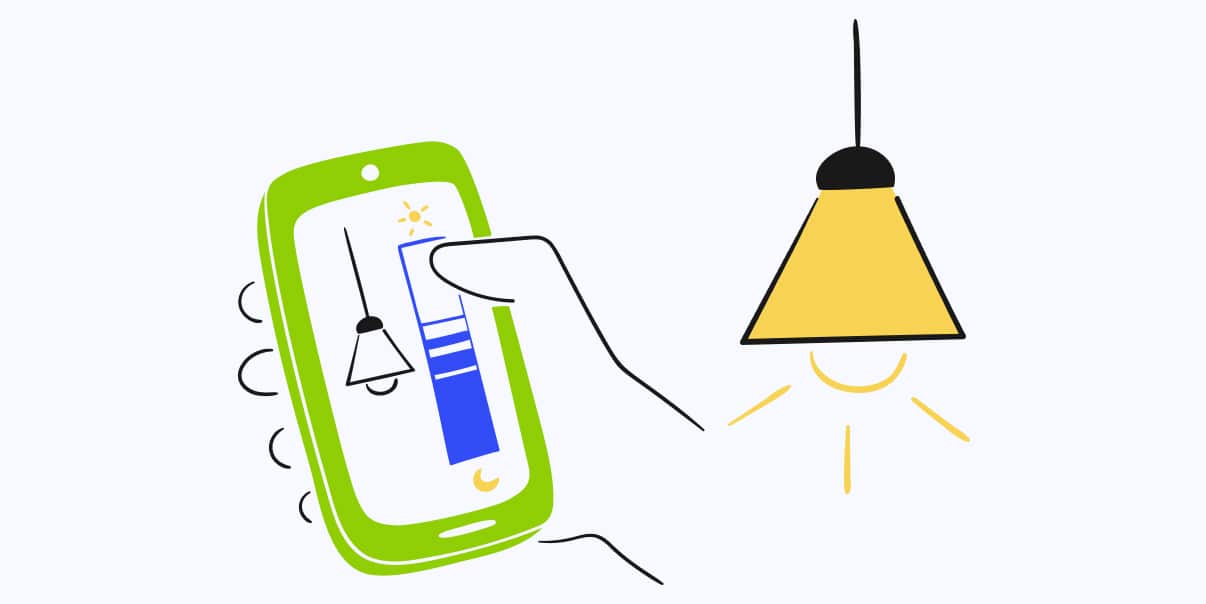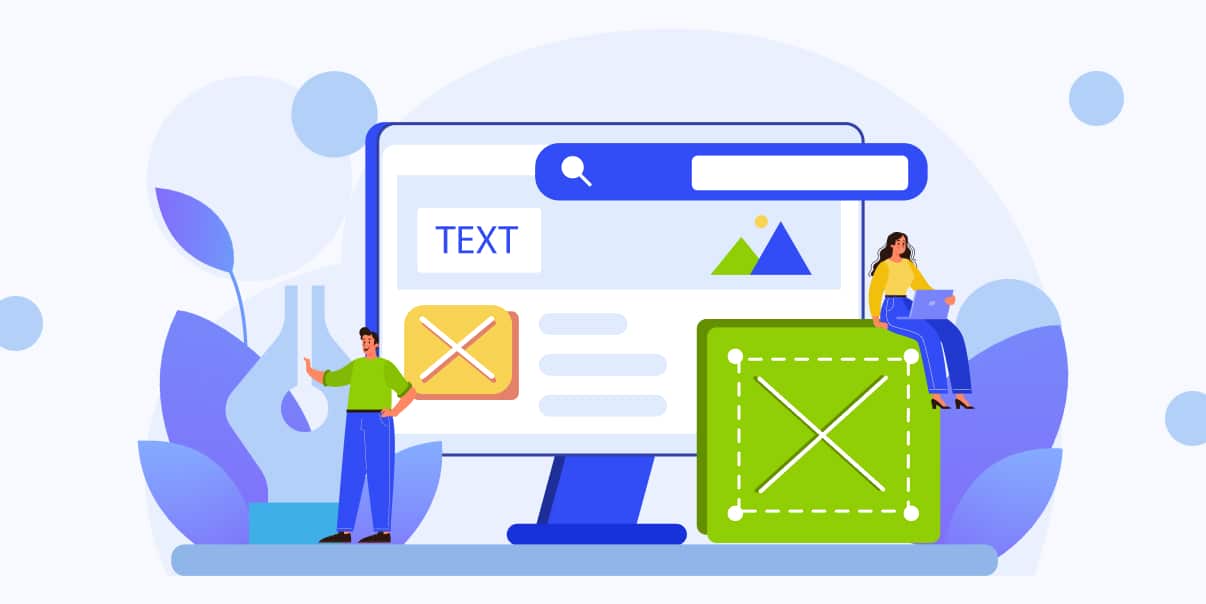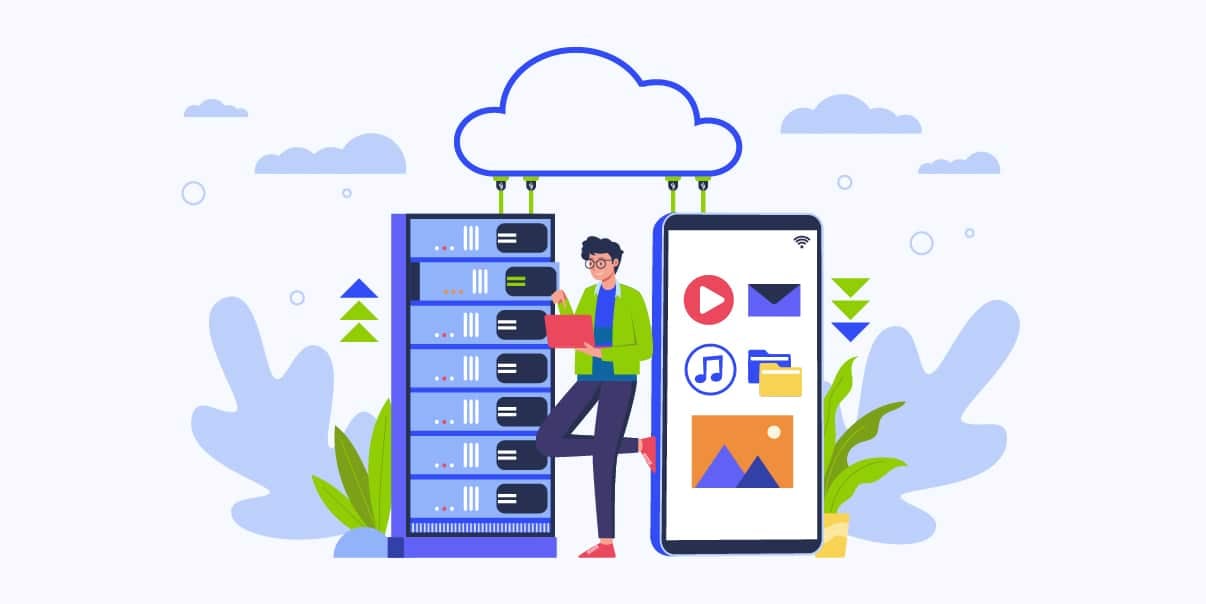IoT Mobile App Development: Benefits, Challenges, Impact
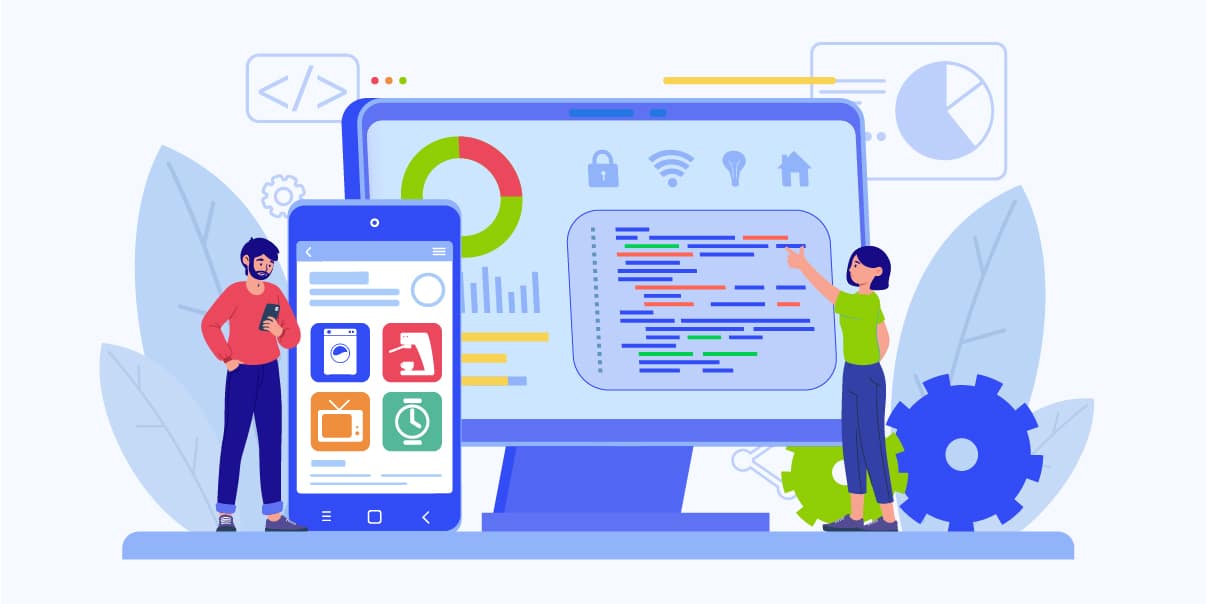
IoT mobile app development involves creating apps that connect physical objects, such as phones and watches, to the internet. These apps give users more control and convenience in their daily lives.
Developing these kinds of apps comes with unique challenges and opportunities for businesses. This article will discuss the potential benefits and risks of developing IoT apps. We’ll also explore the impact of IoT technology on the mobile app development industry.
What Is IoT (Internet of Things)?
The Internet of Things is a network of physical objects connected to the internet. These objects include mobile phones, home appliances, vehicles, medical devices, and industrial equipment. They can communicate with each other and exchange data without requiring manual input.
IoT allows users to remotely control and monitor their smart devices for a more efficient, safer, and smarter environment. These objects can collect and share data, giving users more convenience and control over their daily activities.
Why the IoT Is the Future of Mobile Apps
Experts predict that the IoT market will reach $1.6 trillion by 2025, creating a massive opportunity for businesses and developers. IoT-based apps will become more popular as people rely more on connected devices.
The IoT mobile app market is a gold mine of opportunity for developers. But what makes mobile apps so popular and valuable?
IoT-based apps give users more control over home automation systems and health monitoring devices. These devices leverage cloud computing to enable faster data transfer speeds and better security. Cloud technology makes it easier to create mobile applications over the IoT network.
Connected devices are transforming how we interact with technology and creating a more connected world. As the Internet of Things grows, so will the demand for IoT-based apps.
In the future, mobile app development will be about more than just apps for phones and tablets. It will be about using the Internet of Things to create connected experiences that are safer and more efficient.
Reasons to Build a Custom Mobile App with IoT
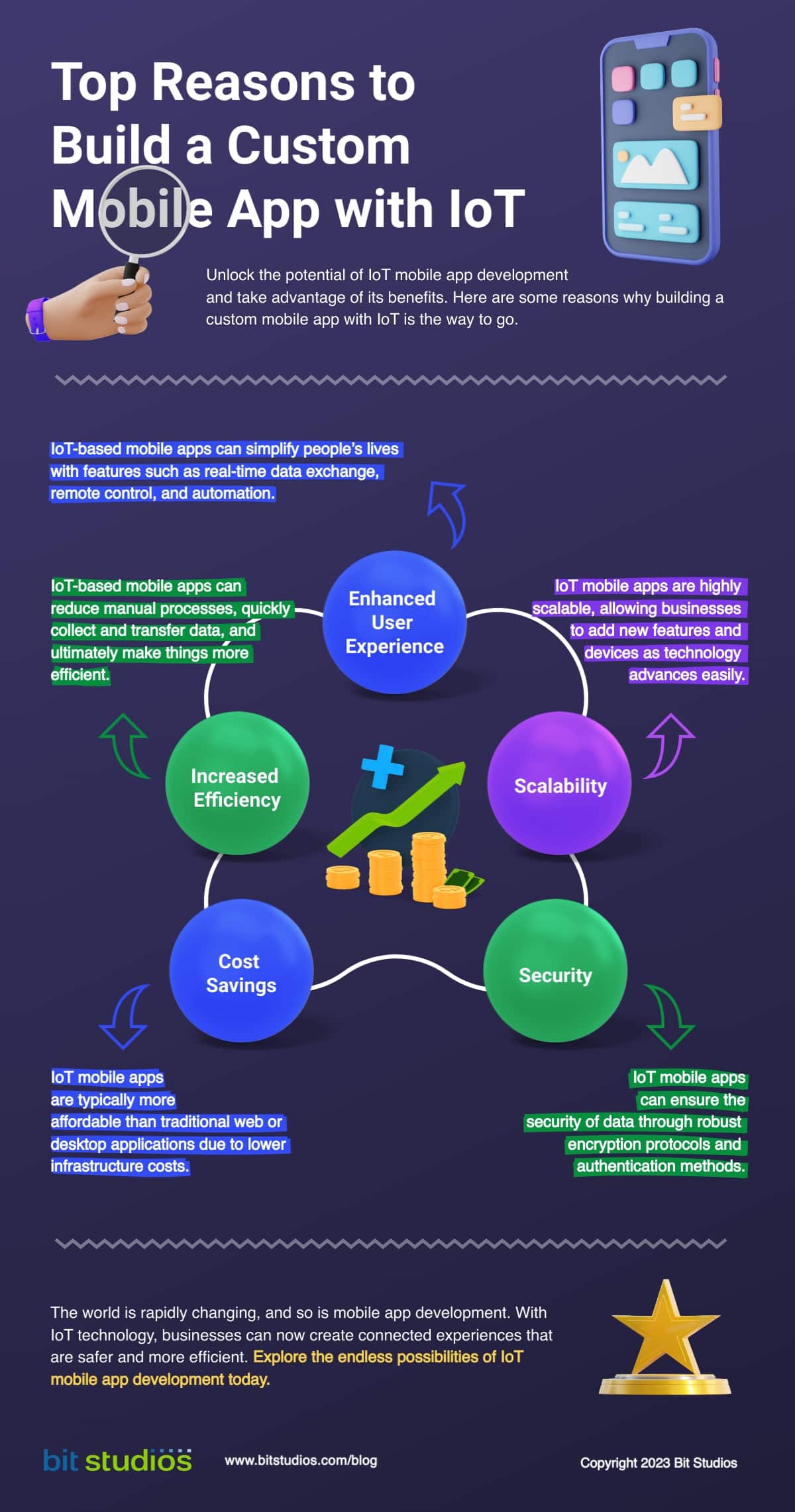
Enhanced User Experience
The IoT allows developers to enhance their product’s user experience. IoT apps have features that simplify people’s lives. These features can include real-time data exchange, remote control, and automation.
Increased Efficiency
IoT-based mobile apps can make things more efficient by reducing manual processes. Connected devices can quickly collect and transfer data, allowing developers to automate specific tasks. That said, the IoT makes mobile applications more efficient and cost-effective.
Cost Savings
IoT mobile apps are typically more affordable than traditional web or desktop applications. It’s because of the lower infrastructure costs associated with cloud computing. These apps also require less maintenance, so businesses can save money in the long run.
Scalability
IoT mobile apps are highly scalable, allowing you to add new features and devices as technology advances easily. It means you can quickly adapt to changes in the IoT market and take advantage of new opportunities.
Security
With an IoT mobile app, businesses can ensure the security of their data. IoT solutions use robust encryption protocols and authentication methods to protect data.
Top Industries With the Biggest Demand for IoT Applications
IoT applications are growing across various industries. Many industries, like manufacturing, healthcare, and retail, benefit from IoT technology. Here are some ways industries use IoT technologies to increase efficiency and productivity:
Healthcare
IoT applications can improve patient care and make medical facilities more efficient. For example, smart devices such as sensors and wearables can help doctors monitor patients’ vital signs in real time.
Manufacturing
IoT systems allow manufacturers to monitor the performance of their machines in real time. For instance, sensors can detect potential machinery problems before they become serious. It helps reduce downtime and keep production running smoothly.
Agriculture
IoT solutions offer farmers many benefits, from improved crop management to better livestock monitoring. Sensors and other intelligent devices help farmers track soil moisture, temperatures, humidity, and more.
Finance
Banks and financial institutions use IoT systems to improve customer service. IoT devices also help with fraud detection, data security, and biometric authentication.
Hospitality
IoT technologies help hotels and resorts create a more personalized and enjoyable stay for their guests. Guests can use a mobile IoT app to monitor energy usage, access room keys, and order room service. They can do all these from the convenience of their mobile devices.
Retail
Retailers are integrating IoT solutions for improved inventory management and customer experiences. IoT allows retailers to track stock and offer features such as payment options, product reviews, and loyalty rewards programs. These features create personalized shopping experiences and increase customer engagement.
Trends in IoT App Development
The IoT mobile app industry is rapidly advancing. Developers are constantly looking for ways to make the most of IoT technology. Here are some of the top trends developers should watch out for:
Increased Use of Artificial Intelligence (AI)
AI is becoming increasingly popular in IoT app development. IoT sensors can collect data, which AI-powered models can use to make decisions and predictions. Leveraging AI allows developers to create more intuitive and intelligent IoT applications.
Real-time Analytics
Real-time analytics is essential for developing consumer IoT. IoT devices generate a lot of data. Developers can use this data to make better user experiences. They can also leverage analytics tools to track user behavior and generate insights.
Cloud Integration
Cloud integration makes IoT mobile apps more robust and reliable. The cloud lets you store data in a secure location without investing in additional infrastructure. It helps reduce costs and enables IoT applications to scale quickly.
Increased Security
IoT applications are getting more and more complex, so security is crucial. The industry is constantly developing robust encryption protocols and authentication methods.
Challenges in IoT Development and How To Overcome Them
Developing IoT applications can be difficult and time-consuming. Here are some of the challenges IoT developers face and how they can overcome them:
- Data Collection and Processing
IoT devices can generate vast amounts of data, which can be challenging to process. Developers must understand how the data is collected and stored to create effective IoT solutions.
Solution: To overcome this challenge, developers should use advanced analytics tools to collect and analyze data efficiently. Doing so allows developers to quickly access, process, and use the data to deliver an efficient solution.
- Security and Privacy
Security and privacy are major concerns when it comes to IoT. IoT applications must be secure enough to protect user data from hackers and malicious actors.
Solution: To ensure the protection of user data, IoT developers must use strong encryption protocols and authentication methods. They should also deploy measures such as intrusion detection systems and firewalls.
- Hardware and Software Compatibility
IoT applications need to be compatible with different types of hardware and software. Ensuring compatibility can be tricky as IoT devices come in various configurations.
Solution: To overcome this challenge, IoT developers must use IoT platforms compatible with various hardware and software. It’s a crucial step in developing apps that run on different IoT devices.
4 Key Elements of IoT Devices Developers Should Know
Developers looking to create IoT applications should have a solid grasp of key elements of connected devices.
- Sensors & Actuators
Sensors and actuators are the essential components of IoT devices. Sensors gather data from the environment, while actuators let users control and manipulate IoT systems. By leveraging these components, IoT systems can collect, store, process, and analyze real-time data to provide valuable insights.
Additionally, actuators can trigger actions based on certain pre-defined conditions. An example is an actuator turning off a light when motion is not detected in a specific room. This way, sensors, and actuators provide the building blocks for the Internet of Things to function effectively.
- Connectivity
IoT applications need devices connected to the internet to send and receive data. IoT devices use Wi-Fi, Bluetooth, and cellular networks to communicate with other devices and the cloud. This way, people can access data anywhere and anytime. Using these networks correctly can create powerful IoT solutions that help people quickly access data.
- Data Processing
IoT devices use software, hardware, and cloud computing to gather data. These technologies make IoT applications more efficient and responsive. This way, users always have the latest information to make decisions quickly. Cloud computing also helps reduce the costs of apps, making them more affordable.
- User Interface
IoT applications need to be user-friendly. IoT devices typically use touchscreens, voice commands, and gestures for easy navigation. These features make it simple for users to interact with the device without needing to learn how to use it. Additionally, effective UI design can reduce frustration and minimize errors, so users keep using the application.
The IoT App Development Process in a Nutshell
IoT app development is complex but can be made simpler with the right approach. Here are the key steps to developing an IoT mobile app:
- Research & Planning
The first step in building an effective IoT mobile app is defining clear goals and objectives. Goals should be measurable and actionable so you can track progress and determine success.
Before developing an app, it’s essential to conduct market research. It will give you a better understanding of your target audience, the competition, and industry trends. This way, you can tailor your solution to meet customer requirements while remaining competitive.
Conducting research also helps developers stay up-to-date with the latest technologies and techniques used in IoT app development. This step will help you make smarter decisions when building your IoT app.
- Design & Development
Now that you know what you want to do, it’s time to start designing and developing your IoT mobile app. IoT-based apps typically use cloud-based platforms, so you must be familiar with web technologies and cloud computing.
During the design process, developers must create interfaces that are intuitive and easy to use. IoT apps must accommodate different devices and platforms, so developers must understand IoT technologies well.
- Testing & Debugging
IoT App testing and debugging are essential to ensure compatibility. IoT mobile app developers must test their apps on different devices and platforms.
Debugging is also essential as IoT applications require a high level of security. Developers must use advanced tools to detect and fix potential bugs before the application can go live.
- Deployment & Maintenance
The last step is to deploy the app to the IoT platform and make it available to users. After the initial launch, developers must stay involved with the app’s monitoring and maintenance.
You can enhance the app’s UX by adding new features or updating existing ones. By staying proactive and engaged, developers can ensure their application’s success in a rapidly changing market.
By following the steps above, developers can create an efficient and secure IoT mobile app that meets the needs of their customers.
Best Examples of Mobile IoT Apps
Consumer IoT apps are transforming how people interact with their environment. Here are some of the best examples of mobile IoT apps:
- Samsung SmartThings
Samsung SmartThings IoT mobile app lets users control their smart home devices from their phones. This app allows users to monitor and control home appliances, lighting, security systems, and more.
- Philips Hue
Philips Hue is an IoT app that lets users control their home lighting system. It allows users to create custom lighting scenes and easily adjust colors, brightness, and temperature.
- Nest
Nest is a home automation app that enables users to control their thermostats, alarms, and cameras from anywhere. It also provides insights into energy usage and helps users save money on their utility bills.
- Fitbit
FitBit IoT mobile app helps users track their activity and set fitness goals. It provides real-time guidance on how to reach their health and wellness goals.
- Ring Doorbells
The Ring IoT mobile app lets users monitor their front door from anywhere in the world. They can view live video streaming, receive notifications when someone rings the doorbell, and unlock the door remotely.
- Tesla
The Tesla IoT mobile app lets users control their cars from their phones. It provides real-time vehicle performance updates and detailed information about battery life and driving range.
These are just a few of the many IoT applications available today. IoT-based mobile app development is one of the most exciting and rapidly growing technological fields.
Conclusion
The IoT app development industry is growing fast. Developers are on the hunt for ways to harness the power of IoT. IoT applications help improve customer service, automate tasks, and increase efficiency in various industries. By understanding the IoT app development process, developers can create efficient and secure products that meet their customers’ needs.
FAQS
IoT apps can improve the efficiency of the transportation and logistics industry. An IoT device can track shipments in real-time, optimize routes, and provide valuable analytics.
Mobile IoT applications are improving the quality of patient care. IoT apps can monitor patients’ vital signs in real-time and detect potential health issues before they become serious. IoT also helps medical facilities reduce costs, improve efficiency, and save time.
The two most popular platforms for developing IoT applications are Android and iOS. Popular tools used in the development process include APIs, SDKs, cloud computing, and machine learning. These tools make the development process faster, easier, and more efficient.
IoT app developers should understand IoT protocols and have hardware and software development skills. They should also have experience in coding languages such as JavaScript, Python, and C++. Moreover, developers should be familiar with database management systems, analytics tools, and cloud computing.
Developing mobile applications for IoT requires a few key steps:
- Define your goals and objectives.
- Design the user interface and develop the backend system.
- Test and debug the mobile IoT app for compatibility, performance, security, and usability.
- Deploy the IoT mobile app to its platform and provide support for users.
We’re BIT Studios!
At BIT Studios we specialize in designing, building, shipping, and scaling beautiful, usable products with blazing-fast efficiency

